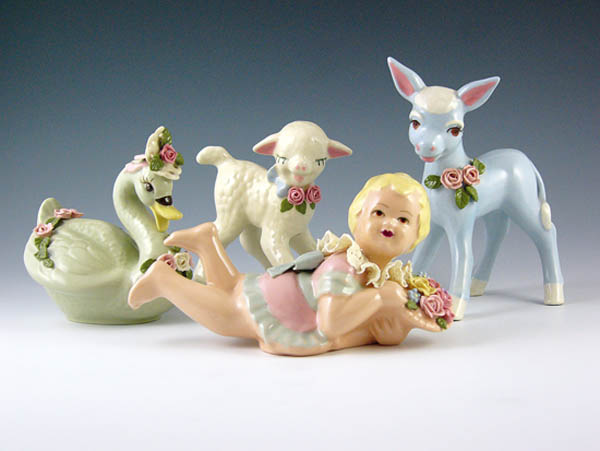"Thoroughly Domesticated: Collectible Animal Figurines"
"Smack Dab In The Middle: Design Trend Of The Mid-20th Century"
The birds and the beasts were there. . ."
Lions. And tigers. And bears. (Oh my!) Plus graceful giraffes. Pert skunks. Elegant zebras and hovering hummingbirds. Paisley pigs, and halo-wearing "holy cows."
Visiting day on Noah's Ark? Nope. Just a zooful of ceramic animal figurines. Lots of birds. Lots of beasts. Lots and lots and lots of them.
During World War II and the decades following, a fun-filled menagerie of ceramic animals beckoned pet lovers from every gift shop window. For just a moment or two, care-filled days became carefree. Because there, cavorting unconcernedly on a knickknack shelf, was a winsome ceramic kitten. . .a playful ceramic pup. . .or, better yet, a ceramic kitten and a ceramic pup! They may not have been as cuddly as the real thing, but with no food bowls to fill, no daily walks to take, and no litter boxes to empty, they were definitely lower maintenance.
Prior to 1940, most inexpensive giftware came from overseas. Then, with the dawn of the war, import gates clanged shut. If America wanted home décor items, America would have to produce them all on its own. Fortunately, the country was up to the challenge.
With so many vital tasks facing the nation, nonessentials were quickly jettisoned. That's why you'll not find "giftware production" on any list of wartime priorities. You will, however, find "morale-boosters" front and center. In the home, even the simplest decorative update served as a breath of fresh air, easing tension-filled times. Giftware may not have been a wartime essential. . .but it certainly was an essential day-brightener.
Most production of ceramic giftware during the 1940s and 1950s centered on the West Coast. (A notable exception was Madison's Ceramic Arts Studio.) A rash of home-based ceramic firms sprang up, their proliferation a result of miniscule budgets and the use of materials not rationed by wartime restrictions: clay and paint.
The majority of these potteries could be described as "mom n pop" operations, although "mom" was usually the guiding force, as "pop" was overseas, fighting for Uncle Sam. In another time and setting, such self-taught artisans might have found their talents confined to creating keepsakes for the family. In wartime, their careers bloomed.
Appealing to a war-weary buying public meant creating figurines with homey themes that soothed, rather than jangled: romantic couples. . .chubby-cheeked children. . .exotically-costumed denizens of other lands. . .historical personages. . .and, of course, animals.
Naturally, there were as many ways of depicting those animals as there were animals to choose from. Take a mouse, for instance: would he be Disney's lovable "Mickey" or a less lovable real-life little fellow wriggling his way out of a trap? The depiction was dependent on the artist and generally fell into one of three overall categories:
Realistic: The artist attempted to replicate, as closely as possible in ceramic, what the actual animal looked like in real life. Colors, proportions, and musculature were carefully studied to best replicate reality. No Pink Panthers here!
Fantasy: These were animals in the abstract. Basic identifying facets (eyes, ears, etc.) were either exaggerated for comic potential or minimized for dramatic effect. The figurine suggests the idea of an animal, rather than mimicking its reality.
Anthropomorphic: Here's where most ceramic animal renditions fall (and where Mickey M. would feel right at home). The animals have been given human-like traits and/or attire. We see an umbrella-hoisting pig or a skunk decked out in picture hat and gloves and accept them as whimsical extensions of our own existence.
Ceramic animal figurines offer up nature in miniature. Once you've paid a visit to this animal kingdom, you won't be able to resist returning time and again. Day-brighteners during World War II, they continue to cast their sunny spell in the present, sure to bring out the animal (or, at any rate, the animal-lover), in all of us.
Donald-Brian Johnson is the co-author of numerous Schiffer books on design and collectibles, including "Postwar Pop," a collection of his columns. Please address inquiries to: donaldbrian@msn.com.

Donald-Brian Johnson
Donald-Brian Johnson is a nationwide columnist, and the co-author of numerous Schiffer books on design and collectibles. His most recent, "Postwar Pop," is a collection of his columns.














